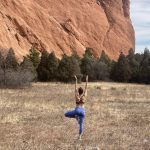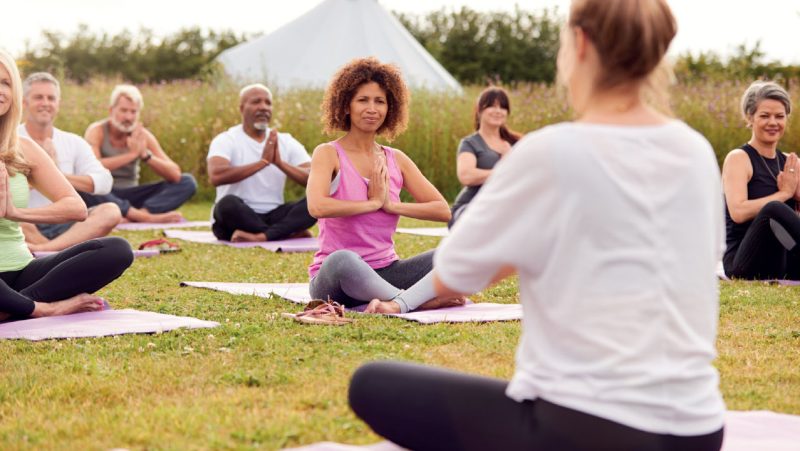
Trauma-informed and diversity-oriented
yoga mantras and theming
How some 'yogic' catchphrases create spiritual bypass, disempower practitioners, and perpetuate trauma, and what mantras and theming to use instead. By Megan Biondi
Jivana Heyman (2021) questions, “why have we stood by and allowed yoga to be cherry-picked for the ideas that reinforce a modern, self-centred approach to life?” This is a question worth asking ourselves as yoga teachers and practitioners. It does seem increasingly common that certain yoga teachers intentionally or unintentionally misuse certain mantras and philosophies to water down yoga to meet their own comfort and privilege.
At the current point in history, if we are indeed to call ourselves experts in the practice, we as yoga teachers must adapt not only our physical practice but also our philosophy to an increasingly diverse body of students. The mantras and dharma talks we share with students must be inclusive of and sensitive to a truly physically and psychologically diverse student body. This contemporary body of yoga practitioners may include students of diverse ethnic and linguistic backgrounds, diverse gender identifications and body types, diverse trauma histories, and diverse degrees of mental health — including body image — to name only a few factors. As yoga teachers, we must take care not to misuse yogic mantras or philosophies to bypass our responsibility to hold safe space for all of the diverse students who come to our classes. This article will describe how and why to avoid four ‘yogic’ mantras that can take on meanings that may be traumatising or triggering for diverse yoga practitioners and what mantras or dharma themes could be used instead to create a safer space for a more diverse body of yoga students.
In an effort to get away from the misuse of ‘yogic’ mantras and philosophy within the yoga community that instead inadvertently disempower diverse students and bypass the teacher’s responsibility to hold safe space for all practitioners, alternative mantras, themes, and philosophical interpretations to the following four mantras will be offered:
- Everything is as it should be…/Everything happens for the evolution of your soul…/Trust the universe…
- Breathe into or breathe through the discomfort…/ Trust the practice or system…
- Just be the light…/I am only love and light…
- Misuse of Karma philosophy: You create your own reality…/You attract your own circumstances…
None of these mantras were originally intended the way in which many teachers now use them, which creates anything but a safe space for historically marginalised groups practicing yoga, whether these groups are ethnically and/or linguistically diverse practitioners, or practitioners with depression, anxiety or negative body image. Each mantra will be explored individually in an effort to understand the problematic meanings they can take on for diverse yoga practitioners.
Everything is as it should be/Everything happens for the evolution of your soul/Trust the universe
Teachers may utter this mantra with the best of intentions without realising that when you have a diverse group of practitioners with potential trauma history, saying “everything happens for the evolution of your soul” is like saying to someone that injustice, violence, or trauma happens for the evolution of their soul. Not knowing if your students’ background might include these events, it’s better to theme around something like: “we can rise from the ashes and learn lessons that make us stronger and wiser in the future based on what happened to us while fully acknowledging that what happened to us was not okay.” This alternate mantra ensures that teachers are not minimising or at worst, somehow validating the trauma by saying it happened for a reason and it was part of the universe’s plan. It can perpetuate trauma for students to hear and internalise the message that disproportionate violence or injustice that happened only to people that look or speak like them was part of the universe’s plan. Reciting this problematic mantra may make teachers from more privileged groups feel more comfortable or less guilty — whether consciously or unconsciously — but it has no benefit for practitioners who have been on the receiving end of systemic injustice.

Breath into or breath through the discomfort/Trust the practice or system
Another problematic spiritual bypass comes with using the mantra “breathe into the discomfort…trust the practice and/or system.” In breathwork and meditation, some teachers tell students to “just breathe/work through” the anxiety some of these practices prompt in them. In yin yoga, some teachers tell students to breathe into the pain and discomfort or to trust the practice. Yoga teachers could be knowingly or unknowingly using these mantras to close an eye to, or not do anything about, real interpersonal conflict and broader social issues, especially ones at the systemic level.
Instead, teachers should focus on letting students know it’s okay to back out if the discomfort of breathwork or a pose is triggering or becomes painful. For students coming from backgrounds marked by systemic exclusion, being told to be with discomfort or trust the practice can be very triggering and cause trauma to resurface. It would be like telling them to trust the system that has contributed to their marginalisation and exclusion or to be okay with the discomfort it causes. The message, especially in a yin class, could instead be “if severe discomfort or pain arises, you are not stuck, you can always make adjustments or get out of the pose.” Certainly, the last thing we want to do is cause yoga to make students practice feeling stuck or make it a practice that teaches them they can’t get out of painful or uncomfortable situations off the mat. Such a message can perpetuate trauma or cause underlying trauma to resurface. Our message to students should be precisely the opposite: "you are never stuck somewhere that is uncomfortable or triggering for you; you can always get out if you need to."
Just be the light/I am only love and light
Sometimes, a winter, or even winter solstice-type yoga theme may call practitioners to 'be the light’, dismissing the experience of people who struggle with mental and physical health during this time of year. From a trauma-informed standpoint, people with anxiety, depression and other kinds of mental illness already feel as though they do not have agency over their own mental state. So, telling them to be the light, which is something they cannot psychologically accomplish, only makes them feel worse. Instead of consciously or unconsciously ignoring, invalidating, or minimising someone else’s mental health struggles by saying ‘just be the light’, a more effective dharma talk could centre around students accepting themselves for however they’re showing up (Brach, 2021). The ‘just be the light’ type of mantra also ignores the fact that many seasonal depression-related mental health issues are actually both physiological and evolutionary (Jacobs, 2018), so making up your mind to feel a different way is anything but scientifically informed and is decidedly trauma-perpetuating for struggling students.
Yoga teachers would do better to lead students in embodiment practices, pointing out to students how much the embodied practice of yoga is linked to the physiological response of the emotions we experience and how this can over time transform negative emotional responses to life events (Jacobs, 2018).
We can positively use somatic psychology to help students to feel better through movement while letting our dharma talk be for students to give grace and acceptance to themselves by telling them that however they are feeling is okay and is not their fault. Giving themselves grace and acceptance is more attainable for students who struggle with mental health than “being the light” and we always want to theme around mantras that feel attainable for diverse students.
Even more problematic is when yoga teachers use the fact that they teach yoga as spiritual bypass to be insensitive or exploitative of students and not accept responsibility for their words and actions. This happens in more extreme cases, but several yoga teachers and gurus throughout history have used and continue to use this type of mantra to avoid seeing their own blind spots and exempt themselves from social engagement, or in the most extreme cases, to excuse physical and emotional abuse of their students. One could be led to believe that it is exactly this type of practice that Heyman (2021) describes when saying “it is deeply ironic that we’ve taken the asceticism of our monastic past and mixed it with enough New Age gobbledygook to transform it into a path that we expect to be lined only in love and light, a path so focused on our individuality that we have lost our humanity.” We have a great responsibility as yoga teachers to not use yoga or yogic mantras to exempt ourselves from humanity or morality.

Misuse of Karma philosophy: You create your own reality/You attract your own circumstances
Along similar lines, many yoga teachers will tell students that they create their own reality. This can be extremely harmful to many groups of yoga students with trauma histories and lived experiences marked by systemic violence, oppression, and marginalisation based on race, ethnicity, gender, or gender identification (Battles & Weber, 2020). For many yoga students, this ‘karma/you create and attract your own reality’ mantra will justifiably come across as victim blaming. The message should instead be a resounding: “You do not create your own reality in many ways. You do not create your own oppression or systemic marginalisation. None of what has happened to you or your ancestors is your fault.”
With law of attraction, as with any other form of positive psychology, we must present these strategies to students with the precedent that we acknowledge their scientific limitations, if we present them at all. We must admit and acknowledge to students that it is more difficult to vibrate higher or attract more positivity if one’s degree of mental health is not in a place of allowing for it (Hanson, 2020). Depression and anxiety are medical conditions caused by a chemical imbalance in the brain and cannot be cured by just “thinking more positively”, “attracting a more positive reality” or “raising one’s vibrations” (Hanson & Hanson, 2018). If it were that simple, no one would ever be depressed! Teaching law of attraction without acknowledging this fact will cause students with clinical depression and anxiety to feel worse because they’ll feel as though it is their fault they cannot “vibrate higher,” while this is certainly not the case.
It is also marginalising for students with trauma histories or backgrounds marked by racism, sexism, and other types of discrimination to subscribe to these theories. Once more, if we present these ideas to students, we must also acknowledge and admit that we do not expect them to heal their trauma with positive thinking or “attracting” positivity alone. Claiming that it is the students’ own job to create or rise above their circumstances when often, their circumstances are marked by horrific forms of injustice, is bypassing our own work of creating safe spaces and trauma-informed practices in yoga and also bypassing our social responsibility to contribute to a world that can reform and repent of systemic injustice. Rising above injustice cannot be pitched as something that is only the internal work of the victims. It is very much a collective, external effort and we as yoga teachers must acknowledged as such to our students.
An even worse form of spiritual bypassing and self-exemption from anti-biased and justice or equality-based work in the yoga community comes with the concept of karma and the idea that “if something’s wrong or unjust, the victim must have created that reality through karma”. If we tell students this — which some yoga teachers traditionally have — we are blaming them for their own suffering. It is a classic case of victim blaming and very obviously not how science, psychology, or sociology actually work. It implies that if you are in any way disadvantaged, marginalised, discriminated against, or oppressed, it is your fault. It also implies that if you live a privileged existence, it must be merit-based, and not possibly based on privilege associated with your skin colour, gender, or association with some other dominant group. Both messages are untrue and convoluted.
Once more, a better message to students could be a theme around giving themselves grace knowing they did not create their circumstances. Any of the following mantras could instead uphold a safe space for all students: “Circumstances happen as a result of various factors”. “It is not your fault”. “You did not create or attract this”. “There’s nothing fundamentally wrong with you”. “It’s the result of a combination of various factors that are out of our control”. “I know I’ll never fully understand, but how can I support you?” Supporting students and creating a safe space for them should be the primary objective of every yoga teacher. In summary, we will not inadvertently perpetuate student trauma if we can come back to this basic objective and responsibility.
The four mantras discussed are ones that the author has observed to be most commonly misused in parts of the yoga community to intentionally or unintentionally minimise the lived experience of diverse individuals and bypass the humanitarian work that yoga should be. There are surely examples beyond these, but what has been offered is a starting point for bringing awareness to a trauma-informed and inclusive yoga practice.
References:
Battles, K. & Weber, K. (2020). Yoga ethics for transforming racism. [Virtual Course].
Brach, T. (2021). Loving Ourselves into Healing. [Virtual Session].
Heyman, J. (2021). Yoga revolution. Shambhala Publications, Inc.
Hanson, F. (2018). Resilient. Harmony Books.
Hanson, R. (2020). Neurodharma. Harmony Books.
Jacobs, H. (2018). It’s not always depression. Random House.
Schwartz, A. (2021). Applied polyvagal theory in yoga: Embodiment strategies for trauma recovery, emotional
health, and physical vitality. Pesi Publishing Inc.
Schwartz, A. (2022). Therapeutic yoga for trauma recovery. Pesi Publishing Inc.
Van der Kolk, B. A. (2015). The body keeps the score. Penguin Books.







